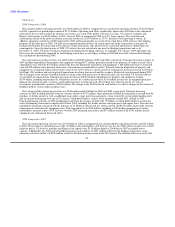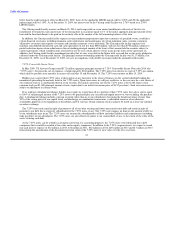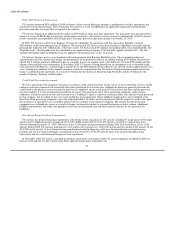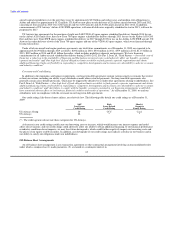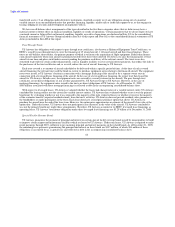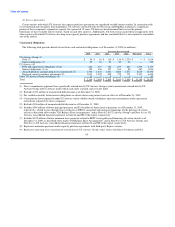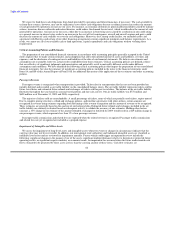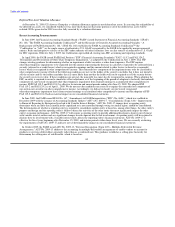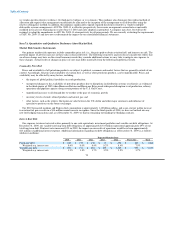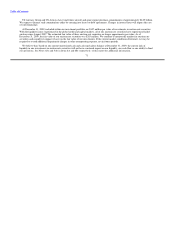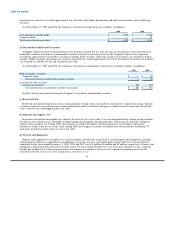US Airways 2009 Annual Report Download - page 70
Download and view the complete annual report
Please find page 70 of the 2009 US Airways annual report below. You can navigate through the pages in the report by either clicking on the pages listed below, or by using the keyword search tool below to find specific information within the annual report.
Table of Contents
Refer to the "Liquidity and Capital Resources" section for further discussion of our investments in marketable securities.
Frequent Traveler Program
The Dividend Miles frequent traveler program awards mileage credits to passengers who fly on US Airways and Star Alliance carriers
and certain other partner airlines that participate in our program. Mileage credits can be redeemed for travel on US Airways or other
participating partner airlines, in which case we pay a fee. We use the incremental cost method to account for the portion of our frequent
traveler program liability related to mileage credits earned by Dividend Miles members through purchased flights. We have an obligation
to provide future travel when these mileage credits are redeemed and have therefore recognized an expense and recorded a liability for
mileage credits outstanding.
The liability for outstanding mileage credits is valued based on the estimated incremental cost of carrying one additional passenger.
Incremental cost includes unit costs incurred by us for fuel, credit card fees, insurance, denied boarding compensation, food and
beverages as well as fees incurred when travel awards are redeemed on partner airlines. In addition, we also include in the determination
of our incremental cost the amount of redemption fees expected to be collected from Dividend Miles members. These redemption fees
reduce our incremental cost. No profit or overhead margin is included in the accrual of incremental cost.
Dividend Miles members may not reach the mileage credit threshold required to redeem a travel award. Additionally, outstanding
mileage credits are subject to expiration if unused. Therefore, in calculating the liability we estimate how many mileage credits will never
be redeemed for travel and exclude those mileage credits from the estimate of the liability. Estimates are also made for the number of
miles that will be used per award redemption and the number of travel awards that will be redeemed on partner airlines. These estimates
are based on historical program experience as well as consideration of enacted program changes, as applicable. Changes in the liability
resulting from members earning additional mileage credits or changes in estimates are recorded in the statement of operations. A change
to certain estimates in the calculation of incremental cost could have a material impact on the liability. At December 31, 2009, we have
assumed 11% of our future travel award redemptions will be on partner airlines. A 1% increase or decrease in the percentage of travel
awards redeemed on partner airlines would have an $8 million impact on the liability as of December 31, 2009.
As of December 31, 2009, the incremental cost liability for outstanding mileage credits expected to be redeemed for future travel
awards accrued on our balance sheet within other accrued expenses was $130 million, representing 129.1 billion mileage credits.
We also sell frequent flyer program mileage credits to participating airline partners and non-airline business partners. Revenue earned
from selling these mileage credits to other companies is recognized in two components. A portion of the revenue from these sales is
deferred, representing the estimated fair value of the transportation component of the sold mileage credits. The deferred revenue for the
transportation component is amortized on a straight-line basis over the period in which the credits are expected to be redeemed for travel
as passenger revenue, which is currently estimated to be 28 months. The marketing component, which is earned at the time the miles are
sold, is recognized in other revenues at the time of the sale. As of December 31, 2009, we had $212 million in deferred revenue from the
sale of mileage credits included in other accrued expenses on our balance sheet. A change to the estimated fair value of the transportation
component could have a significant impact on revenue. A 10% increase or decrease in the estimated fair value of the transportation
component would have a $17 million impact on revenue recognized in 2009.
The number of travel award redemptions during the year ended December 31, 2009 was approximately 0.8 million, representing
approximately 4% of US Airways' mainline RPMs during that period. The use of inventory management techniques minimizes the
displacement of revenue passengers by passengers traveling on award tickets.
68



